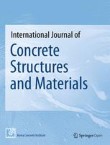International Journal of Concrete Structures and Materials is affiliated with Korea Concrete Institute.
Optimal Use of MSWI Bottom Ash in Concrete
An experimental investigation was carried out to evaluate the mechanical properties of concrete mixtures in which coarse aggregate was partially (30, 50 or 70 %) replaced with pre-washed municipal solid waste ...
